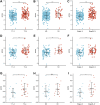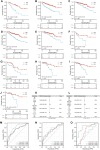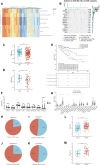An inflammation-related signature could predict the prognosis of patients with kidney renal clear cell carcinoma
- PMID: 36035192
- PMCID: PMC9405188
- DOI: 10.3389/fgene.2022.866696
An inflammation-related signature could predict the prognosis of patients with kidney renal clear cell carcinoma
Abstract
Background: Kidney renal clear cell carcinoma (KIRC) is an inflammation-related carcinoma, and inflammation has been recognized as an important factor in inducing carcinogenesis. To further explore the role of inflammation in KIRC, we developed an inflammation-related signature and verified its correlation with the tumor micro-environment. Methods: After the differential inflammation-related prognostic genes were screened by Lasso regression, the inflammation-related signature (IRS) was constructed based on the risk score of multivariate Cox regression. Then, the prognostic value of the IRS was evaluated by Kaplan-Meier analysis, receiver operating characteristic (ROC) curve analysis and multivariate Cox regression. Gene set variation analysis (GSVA) was applied to screen out enriched signaling pathways. Infiltrated immune cells, tumor mutational burden (TMB) and immune checkpoints were explored by CIBERSORTx and maftool. Results: Four genes (TIMP1, PLAUR, CCL22, and IL15RA) were used to construct the IRS in patients with KIRC. Kaplan-Meier analysis and multivariate Cox regression identified that the IRS could independently predict the prognosis of patients with KIRC in the training and validation groups. The diagnostic value of the nomogram increased from 0.811 to 0.845 after adding the IRS to the multiparameter ROC analysis. The GSVA results indicated that IRS was closely related to primary immunodeficiency and antigen processing and presentation. The immune checkpoint LAG3 was highly expressed in patients with high-risk score (p < 0.05), while CD274 (PD-L1) and HAVCR2 were highly expressed in patients with low-risk score (p < 0.001). There was a significant positive correlation between the high-risk score group and CD8+ T, activated CD4+ memory T, gamma and delta regulatory T and M0 macrophage cells, while the low-risk score group was negatively associated with B memory, plasma, resting CD4+ memory T, activated NK, M1 macrophages and resting mast cells. Conclusion: We found that the IRS might serve as a biomarker to predict the survival of KIRC. Moreover, patients with high or low-risk score might be sensitive to immune drugs at different immune checkpoints.
Keywords: immune checkpoint; immune infiltration; inflammation; renal clear cell carcinoma; signature.
Copyright © 2022 Yu, Zhang, Feng, Li, Xia and Gan.
Conflict of interest statement
The authors declare that the research was conducted in the absence of any commercial or financial relationships that could be construed as a potential conflict of interest.
Figures







Similar articles
-
A Novel Gene Signature of Tripartite Motif Family for Predicting the Prognosis in Kidney Renal Clear Cell Carcinoma and Its Association With Immune Cell Infiltration.Front Oncol. 2022 Mar 17;12:840410. doi: 10.3389/fonc.2022.840410. eCollection 2022. Front Oncol. 2022. PMID: 35371994 Free PMC article.
-
The clinical significance, immune infiltration, and tumor mutational burden of angiogenesis-associated lncRNAs in kidney renal clear cell carcinoma.Front Immunol. 2022 Jul 26;13:934387. doi: 10.3389/fimmu.2022.934387. eCollection 2022. Front Immunol. 2022. PMID: 35958561 Free PMC article.
-
Cuproptosis-related gene FDX1 as a prognostic biomarker for kidney renal clear cell carcinoma correlates with immune checkpoints and immune cell infiltration.Front Genet. 2023 Jan 23;14:1071694. doi: 10.3389/fgene.2023.1071694. eCollection 2023. Front Genet. 2023. PMID: 36755576 Free PMC article.
-
GRAMD1A Is a Biomarker of Kidney Renal Clear Cell Carcinoma and Is Associated with Immune Infiltration in the Tumour Microenvironment.Dis Markers. 2022 Jul 11;2022:5939021. doi: 10.1155/2022/5939021. eCollection 2022. Dis Markers. 2022. PMID: 35860689 Free PMC article.
-
Construction and validation of an autophagy-related long noncoding RNA signature for prognosis prediction in kidney renal clear cell carcinoma patients.Cancer Med. 2021 Apr;10(7):2359-2369. doi: 10.1002/cam4.3820. Epub 2021 Mar 2. Cancer Med. 2021. PMID: 33650306 Free PMC article.
Cited by
-
The complex interplay of tumor-infiltrating cells in driving therapeutic resistance pathways.Cell Commun Signal. 2024 Aug 19;22(1):405. doi: 10.1186/s12964-024-01776-7. Cell Commun Signal. 2024. PMID: 39160622 Free PMC article. Review.
-
Exploring the prognostic role and expression patterns of FAM3A family genes in kidney renal clear cell carcinoma.Sci Rep. 2025 Jul 1;15(1):22397. doi: 10.1038/s41598-025-05658-x. Sci Rep. 2025. PMID: 40594565 Free PMC article.
-
Exploring the role of ADAMTSL2 across multiple cancer types: A pan-cancer analysis and validated in colorectal cancer.Discov Oncol. 2024 Oct 9;15(1):538. doi: 10.1007/s12672-024-01401-6. Discov Oncol. 2024. PMID: 39384622 Free PMC article.
-
Adhesion-regulating molecule 1 (ADRM1) can be a potential biomarker and target for bladder cancer.Sci Rep. 2023 Sep 8;13(1):14803. doi: 10.1038/s41598-023-41992-8. Sci Rep. 2023. PMID: 37684377 Free PMC article.
-
Inflammation and Immunity Gene Expression Patterns and Machine Learning Approaches in Association with Response to Immune-Checkpoint Inhibitors-Based Treatments in Clear-Cell Renal Carcinoma.Cancers (Basel). 2023 Nov 29;15(23):5637. doi: 10.3390/cancers15235637. Cancers (Basel). 2023. PMID: 38067341 Free PMC article.
References
-
- Borrelli C., Ricci B., Vulpis E., Fionda C., Ricciardi M. R., Petrucci M. T., et al. (2018). Drug-induced senescent multiple myeloma cells elicit NK cell proliferation by direct or exosome-mediated IL15 trans-presentation. Cancer Immunol. Res. 6 (7), 860–869. 10.1158/2326-6066.Cir-17-0604 - DOI - PubMed
-
- De Mattia E., Polesel J., Roncato R., Labriet A., Bignucolo A., Gagno S., et al. (2021). IL15RA and SMAD3 genetic variants predict overall survival in metastatic colorectal cancer patients treated with folfiri therapy: A new paradigm. Cancers (Basel) 13 (7), 1705. 10.3390/cancers13071705 - DOI - PMC - PubMed
LinkOut - more resources
Full Text Sources
Research Materials
Miscellaneous

